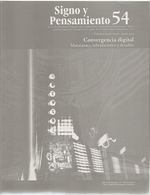Abstract
The Information and Communication Society introduced the use of it in the midst of everyday life and modified conventional wisdom concerning media and its processes of communication. Thus, new mobility conditions were created based on the imaginary assumption (or prejudice) that the young are more competent than adults vis-à-vis the use of it. Nevertheless, it has been established that the young aren’t aware of the it’s reach and range, because they use them as entertainment rather than as a tool to communicate, research, and analyze our society.
García Canclini, N. (2004), Diferentes, desiguales, desconectados: mapas de la interculturalidad, Barcelona, Gedisa.
González, J. (2001), “Cibercultura en el diseño de políticas culturales”, en: Cátedra de Políticas Culturales del Ministerio de Cultura, Bogotá, Ministerio de Cultura.
López García, G. (2005), Modelos de comunicación en Internet, Valencia, Tirant lo Blanch.
Lucas Marín, A. (2000), La nueva sociedad de la información, Madrid, Trotta.
Mancini, P. (2004), “Vivir en la pantalla. Desordenamientos en una sociedad-audiencia que aprende” [resumen de la conferencia de Guillermo Orozco Gómez “Desordenamiento mediático educativo en una sociedad-audiencia que aprende”], en: Foro de Comunicación y Cultura, 11.° Festival Latinoamericano de Video de Rosario, disponible en: http://weblog.educ.ar/educacion-tics/ archives/002567.php.
Martín-Barbero, J. (1987), De los medios a las mediaciones: comunicación, cultura y hegemonía, México, Gustavo Gili.
(2002), Oficio de cartógrafo: travesías latinoamericanas de la comunicación en la cultura, México, FCE.
Orozco, G. (1991), “Recepción televisiva: tres aproximaciones y una razón para su estudio”, en Cuadernos de Comunicación y Prácticas Sociales, núm. 2, México, Universidad Iberoamericana.
Paoli, A. (1983), Comunicación e información: perspectivas teóricas, México, Trillas.
Pineda, M. (2000), El papel de Internet como nuevo medio de comunicación social en la era digital [en línea], disponible en http://hiper-textos. mty.itesm.mx/mainframe_3htm.
Prieto, D. (1996), Palabras e imágenes para la comunicación impresa: curso a distancia en comunicación impresa, Quito, UCLAP.
Rodrigo Alsina, M. (2001), Teorías de la comunicación: ámbitos, métodos y perspectivas, Valencia, Universitat de Valencia, Universitat Jaime I, Universitat Pompeu Fabra, Universitat Autonoma de Barcelona.
Sandoval Martín, M. T. (2000), “Algunas cuestiones sobre el uso de Internet para los próximos años”, en: Revista Latina de Comunicación Social, núm. 31, disponible en http//:www.ull.es/publicaciones/latina/aa2000kjl/ z31jl/88sandoval.htm.
Tapscott, D. (1998), Creciendo en un entorno digital: la generación Net, Bogotá, McGraw-Hill.
This journal is registered under a Creative Commons Attribution 4.0 International Public License. Thus, this work may be reproduced, distributed, and publicly shared in digital format, as long as the names of the authors and Pontificia Universidad Javeriana are acknowledged. Others are allowed to quote, adapt, transform, auto-archive, republish, and create based on this material, for any purpose (even commercial ones), provided the authorship is duly acknowledged, a link to the original work is provided, and it is specified if changes have been made. Pontificia Universidad Javeriana does not hold the rights of published works and the authors are solely responsible for the contents of their works; they keep the moral, intellectual, privacy, and publicity rights.
Approving the intervention of the work (review, copy-editing, translation, layout) and the following outreach, are granted through an use license and not through an assignment of rights. This means the journal and Pontificia Universidad Javeriana cannot be held responsible for any ethical malpractice by the authors. As a consequence of the protection granted by the use license, the journal is not required to publish recantations or modify information already published, unless the errata stems from the editorial management process. Publishing contents in this journal does not generate royalties for contributors.


